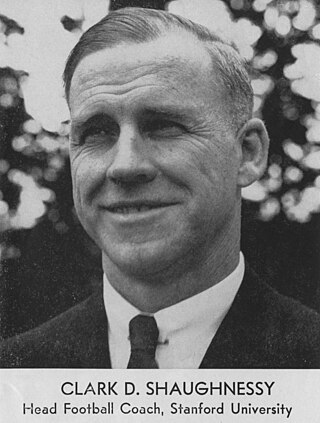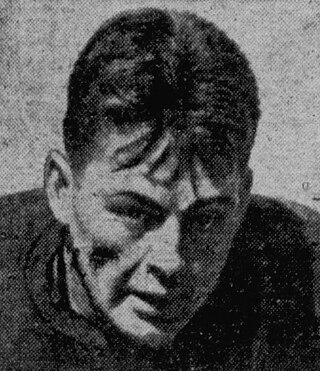Related Research Articles
The 1941 College Football All-America team is composed of college football players who were selected as All-Americans by various organizations and writers that chose College Football All-America Teams in 1941. The nine selectors recognized by the NCAA as "official" for the 1941 season are (1) Collier's Weekly, as selected by Grantland Rice, (2) the Associated Press, (3) the United Press, (4) the All-America Board, (5) the International News Service (INS), (6) Liberty magazine, (7) the Newspaper Enterprise Association (NEA), (8) Newsweek, and (9) the Sporting News.

The 1941 Stanford Indians football team represented Stanford University as a member of the Pacific Coast Conference (PCC) during the 1941 college football season. Second-year head coach Clark Shaughnessy led the team to a 6–3 record. Before the season, Stanford, which the year prior had finished 10–0, was considered a favorite for the national championship, but three conference losses put it out of contention for a return to the Rose Bowl. After the season, Shaughnessy left Stanford to take over as head coach at the University of Maryland.

Robert James Robertson was an American professional football player who played one season with the Brooklyn Dodgers of the National Football League (NFL). He was selected by the Dodgers with the seventh overall pick of the 1942 NFL draft after playing college football at the University of Southern California.

Robert Richard Reinhard was an American professional football player who played four seasons with the Los Angeles Dons of the All-America Football Conference (AAFC) and one season with the Los Angeles Rams of the National Football League (NFL). He was selected by the Chicago Cardinals of the National Football League (NFL) in the fifth round of the 1942 NFL draft after playing college football at the University of California, Berkeley.
The 1957 All-Pacific Coast football team consists of American football players chosen by various organizations for All-Pacific Coast teams for the 1957 college football season.
The 1956 All-Pacific Coast Conference football team consists of American football players chosen by the Associated Press (AP) and the United Press (UP) as the best college football players by position in the Pacific Coast region during the 1956 college football season. The AP team was limited to players form the Pacific Coast Conference (PCC) and was based on votes of football writers of AP member newspapers on the west coast. The UP team included players from non-PCC schools.
The 1955 All-Pacific Coast football team consists of American football players chosen by the Associated Press (AP) and the United Press (UP) as the best college football players by position in the Pacific Coast region during the 1955 college football season. The AP team was limited to players form the Pacific Coast Conference (PCC) and was based on votes of football writers of more than 20 AP member newspapers on the west coast. The UP team included players from non-PCC schools.
The 1954 All-Pacific Coast Conference football team consists of American football players chosen by the Associated Press (AP) and the United Press (UP) as the best college football players by position in the Pacific Coast Conference (PCC) during the 1954 college football season. The AP team was based on votes by AP member football writers on the west coast. The UP team was based on the choices of sports writers with assistance from the PCC coaches. The AP selections were limited to players from the AP, whereas the UP selections included non-PCC players on the second and third teams.
The 1950 All-Pacific Coast football team consists of American football players chosen by various organizations for All-Pacific Coast teams for the 1950 college football season.
The 1939 All-Pacific Coast football team consists of American football players chosen by various organizations for All-Pacific Coast teams for the 1939 college football season. The organizations selecting teams in 1939 included the Associated Press (AP) and the United Press (UP).
The 1937 All-Pacific Coast football team consists of American football players chosen by various organizations for All-Pacific Coast teams for the 1937 college football season. The organizations selecting teams in 1937 included the Associated Press (AP), the International News Service (INS), and the United Press (UP).
The 1935 All-Pacific Coast football team consists of American football players chosen by various organizations for All-Pacific Coast teams for the 1935 college football season. The organizations and individuals selecting teams in 1935 included the Associated Press (AP), USC head coach Howard Jones (HJ), the Newspaper Enterprise Association (NEA), The Oregon Statesman (OS), the United Press (UP), and UCLA coach William H. Spaulding (WS).
The 1934 All-Pacific Coast football team consists of American football players chosen by various organizations for All-Pacific Coast teams for the 1934 college football season. The organizations selecting teams in 1934 included the Associated Press (AP), the Newspaper Enterprise Association, and the United Press (UP).
The 1940 All-Pacific Coast football team consists of American football players chosen by various organizations for All-Pacific Coast teams for the 1940 college football season. The organizations selecting teams in 1940 included the Associated Press (AP) and the United Press (UP).
The 1947 All-Pacific Coast football team consists of American football players chosen by various organizations for All-Pacific Coast teams for the 1947 college football season. The organizations selecting these teams included the conference coaches, the Associated Press (AP), and the United Press (UP).
The 1948 All-Pacific Coast football team consists of American football players chosen by various organizations for All-Pacific Coast teams for the 1948 college football season. The organizations selecting these teams included the conference coaches, the Associated Press (AP), and the United Press (UP).
The 1936 All-Pacific Coast football team consists of American football players chosen by various organizations for All-Pacific Coast teams for the 1936 college football season.
The 1938 All-Pacific Coast football team consists of American football players chosen by various organizations for All-Pacific Coast teams for the 1938 college football season. The organizations selecting teams in 1938 included the Associated Press (AP), the International News Service (INS), and the United Press (UP).
The 1942 All-Pacific Coast football team consisted of American football players chosen by various organizations for All-Pacific Coast teams for the 1942 college football season. The organizations selecting teams in 1942 included the Associated Press (AP) and the United Press (UP).
The 1946 All-Pacific Coast football team consists of American football players chosen by various organizations for All-Pacific Coast teams for the 1946 college football season. The organizations selecting teams in 1946 included the Associated Press (AP) and the United Press (UP).
References
- 1 2 3 4 "Only One Oregon State Player Named On All-Pacific Coast Football Team". The Hartford Courant. December 4, 1941. p. 19 – via Newspapers.com.
- 1 2 3 4 "Mecham Fails to Make Either A.P. or U.P. All-Coast Team". The Register-Guard, Eugene, Oregon. December 4, 1941. p. 15.